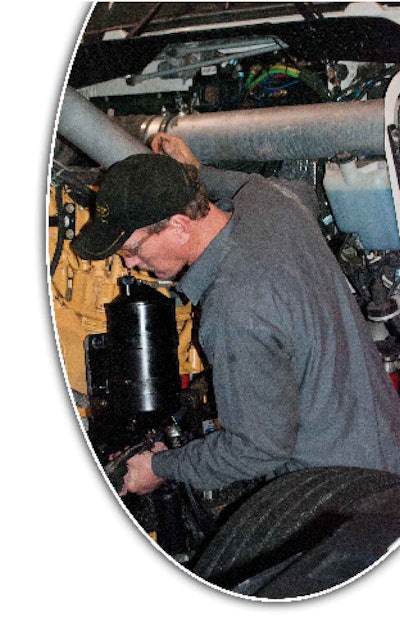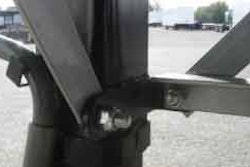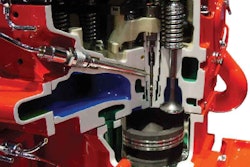Synthetic lubricants offer long-term cost benefits and better performance in extreme temperatures.
Synthetic oils cost more than mineral oils but save money over the long run. Beyond the cost benefits, synthetics deliver superior performance under most temperatures and operating conditions, say their makers.
 One advantage of using synthetic oil is the reduced downtime that comes with having extended drain periods.
One advantage of using synthetic oil is the reduced downtime that comes with having extended drain periods.While synthetics are more than twice as expensive as mineral lubes, that’s only part of the story. The recommended change interval for a mineral lube in a drivetrain component may be 125,000 miles or less, while the synthetic lube interval is 500,000 miles. To hit a million miles, you’ll replace a synthetic lube only once, while you’d replace a mineral lube seven times. You’ll also spend more on downtime and disposal.
Synthetic oil base stocks enable refiners to create engine oils with “better thermal stability,” says Maria Burcham, a technical advisor with ExxonMobil. This means oil changes are extended because heat won’t break down synthetics as fast as mineral lubes.
Thermal stability is critical in keeping oil viscosity high enough for proper component protection, especially when running under heavy loads at high temperatures. This gets complex in engines, where extending changes presents more problems because of all the by-products of combustion that inevitably end up in the oil. Sometimes the accumulation of acids and soot means the quality of the base oil will have little effect on when a change will be required.

Still, it’s clear that synthetics are ideally suited for use in the transmission and axles, where combustion by-products are not part of the equation.
Another advantage of synthetics is cold performance. Though they’re every bit as thick or “viscous” at normal operating temperatures as mineral lube, when starting out on a cold morning, synthetics will make shifting much easier because they start out thinner.
“Synthetics offer both superior low temperature performance and a high level of film strength at high temperatures to better protect all moving parts,” says Dan Arcy, a technical manager at Shell Lubricants. The fluid will be thin enough to flow easily and quickly reach all parts when you start up on a cold morning, yet it will remain more than thick enough when running at high speeds on a hot day.
Component makers stand behind their belief in synthetics’ extra protection by offering extended warranties – typically up to 750,000 miles on drivetrain components. The extra protection helps guard against component problems, protecting companies from having to pay warranty claims. You can typically keep the warranty in effect if you change the fluid, using an approved lube as the replacement, at 500,000 miles. In addition, gearboxes end up looking a lot cleaner inside at overhaul when synthetic lube has been used.
Arcy says one circumstance where the use of mineral lubes in drivetrain components might be preferred is when contamination is high, as when working in extreme dust. In such cases, inspect the lube daily and replace it as frequently as it gets dirty or diluted with a less expensive mineral lube.
Arcy also notes the critical difference between transmission and axle lubes and the importance of using the right one. Transmission gear teeth are generally flat and the gears sit directly across from one another. In a drive axle, the large ring gear sits at the level of the wheel bearings, but the pinion gear that drives it is off-center and is at 90 degrees. The gear teeth in the drive axle rub together much more, requiring special extreme pressure additives.
EP additives work fine with parts in a differential, but transmissions have synchronizer clutches made of yellow metals like brass and bronze. The EP additives can corrode those parts and cause serious damage, and the higher operating temperature of the transmission can accelerate the effect. Additives in transmission lubes, unlike those for drive axles, are adapted to the heat.
Fortunately, the viscosity scales differ to help set the two lubes apart. Drive axles might use a 75W-90 lube, while a transmission typically uses a 50-weight lubricant.
Synthetic in the engine
The most basic reason for using a synthetic in the engine is its superior performance in extreme cold.
Major refiners offer not only 15W-40 mineral oil, but also 5W-40 synthetic diesel engine oil. “Chevron’s Delo 400 LE Synthetic 5W-40 is a full synthetic product blended with synthetic base oils, and it’s targeted for those customers that want full synthetic protection in extreme climate conditions, specifically cold weather environments,” says Len Badal of Chevron Global Lubricants.
Dan Arcy of Shell Lubricants says a 15W oil flows well down to 5 degrees while a 10W is good down to minus 5 degrees, a 5W down to minus 25 degrees.
In extreme cold, ExxonMobil’s Maria Burcham says synthetics and synthetic blends produce faster starts, saving the batteries and starter, while also providing better protection against engine wear during the first few minutes of operation. Lower viscosity oils result in faster cranking speeds, which not only reduce the amps the starter draws but increase the temperature compression produces in the cylinders, giving quicker firing of the fuel.
After a cold start, almost all the oil ends up in the crankcase when the engine sits overnight. If, under these conditions, the oil pumps more quickly and circulates more freely, the wear surfaces will be lubricated more quickly with a lower viscosity oil, and wear will be reduced. The other justification for using synthetic engine oil is the possibility that it may allow extended changes.
Extending oil changes
Approaches differ among refiners when it comes to adopting synthetics for extending engine oil changes.
Chevron’s Len Badal, when comparing performance of the company’s Delo 400 LE 15W-40 and 10W-30 mineral oils with its synthetic 5W-40, sees a battle of equals. “Both products will provide extended service protection,” he notes, because mineral oils keep getting closer and closer to synthetics in performance due to improving refining. Still, the best synthetics, when specifically designed to provide extended life, are generally considered to have a clear edge.
ExxonMobil’s Maria Burcham says less maintenance and better longevity come with synthetic use. “Better semi-synthetic and full synthetic base oils in conjunction with better additives provide superior protection against corrosive and abrasive wear,” she says.
Shell’s Arcy agrees on the oil durability issue, saying full synthetics “have better oxidation stability.” This means they will survive longer without losing their viscosity or becoming acidic.
Even with super oils, Arcy says “optimizing” drains should be the focus more than extending drains because it is impossible to accurately predict well in advance the correct times to change. One thing that affects the drain time is maintenance of the cooling system, air induction system and other basic systems that can impact the rate at which oil deteriorates.
Finally, since oil gets contaminated even in properly maintained engines, a careful program of oil analysis is essential to help determine what factor is limiting the life of the oil, and whether or not the lubricant choice will help the problem. Arcy says, “If the condemning factor is fuel dilution, a synthetic might help, but if it’s high soot, it won’t change the interval much.” n
The synthetic oil payback
Even though it often costs twice as much as standard mineral oil, synthetic oil can be a more effective engine oil choice when other factors are considered.
This example is based on a truck traveling 120,000 miles/year moving from 15,000-mile changes to 40,000 miles, and moving from a $17 per gallon mineral oil to a $34 per gallon synthetic. Filters are changed once per change with mineral oil, and twice per change (once midway in the change cycle) with synthetic.
Using synthetics are even more cost-effective if reduced disposal costs and downtime apply to your operation.
Standard Mineral Oil
$17/gallon x 11 gallons
x 8 changes = $1,496
$24 filter
x 8 changes = $192
Labor per change
$44 x 8 = $352
ANNUAL COST $2,040
Premium Synthetic Oil
$34/gallon x 11 gallons
x 3 changes = $1,122
$24 filter
x 6 changes = $144
Labor per oil and
filter change $44 x 3 = $132
Labor per filter
change $20 x 3 = $60
ANNUAL COST $1,458













